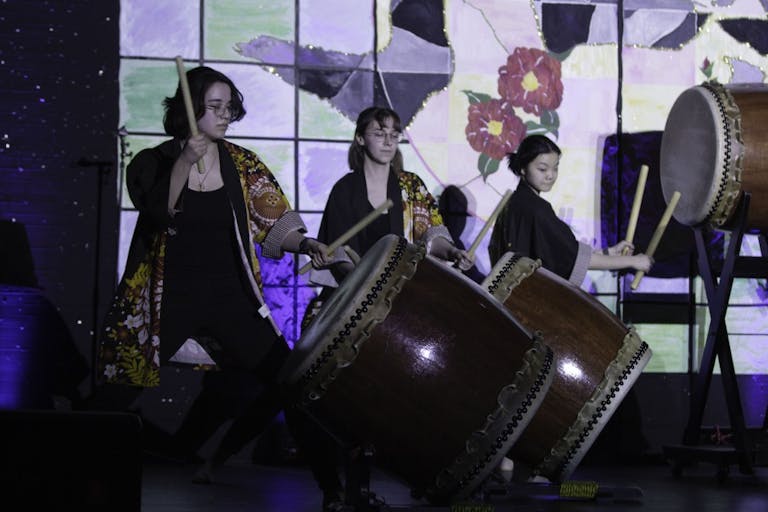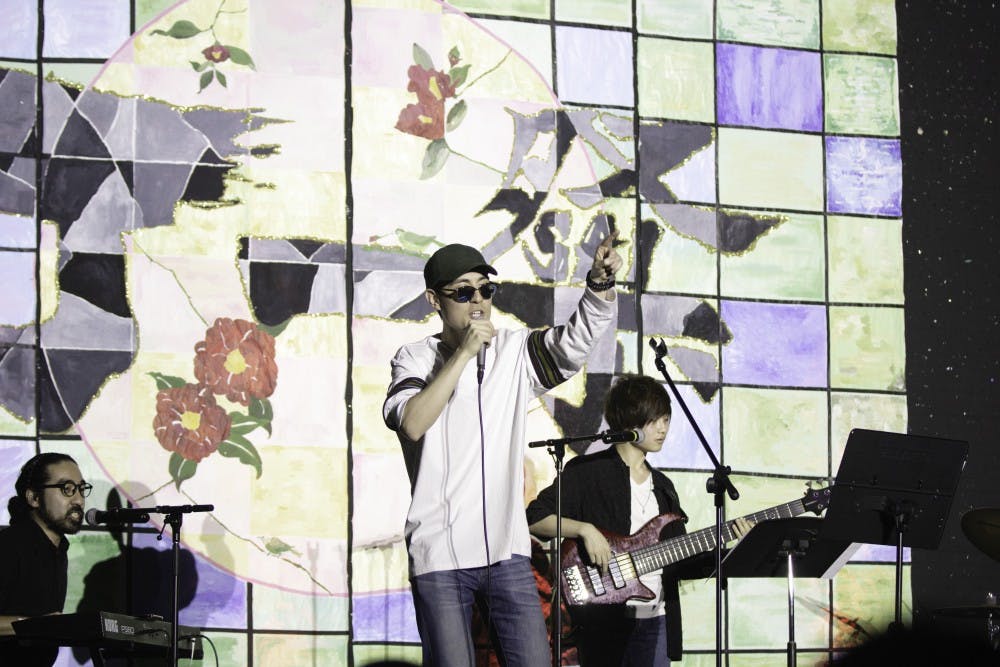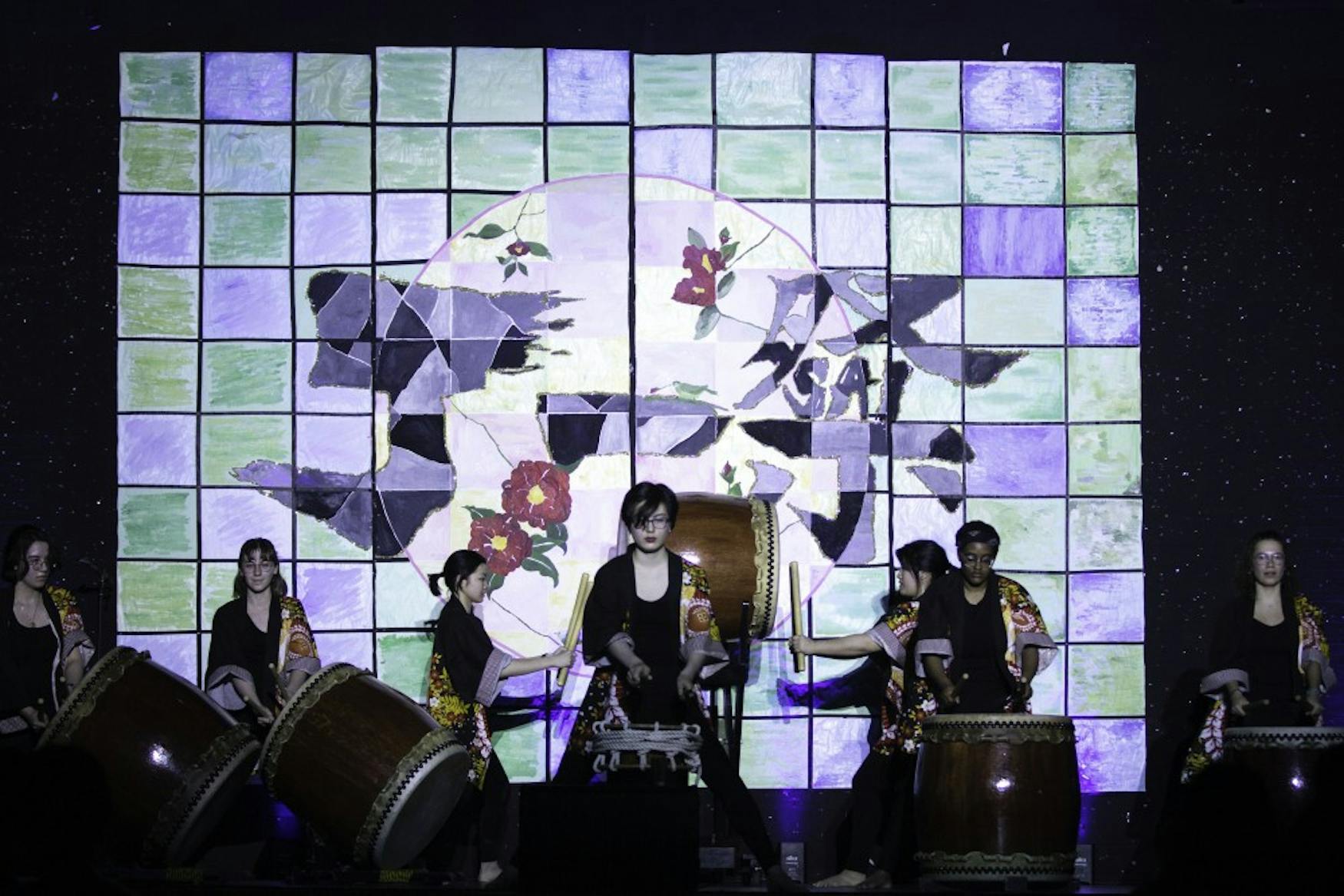Time travel with J-SAI
The Japanese Student Association held their culture show in the Levin Ballroom for the first time last Friday. They called the show J-SAI, an amalgamation of “Japan” and the kanji, the logographic character in Japanese, for “festival,” which can be pronounced either as matsuri or sai. This title was all JSA needed for their beautiful stage backdrop: a stylized version of J-SAI surrounded with flowers and a grid pattern of green and blue squares.

BEATS AND RHYTHM: Students provided a variety of performances, from a fashion show to taiko drumming.
J-SAI began with a performance segment and ended with a matsuri, which provided an array of Japanese-style games and food. This was a change from their past events in Sherman Function Hall, which combined the performance and matsuri segments. That combination meant that “people would come and go [and] they would pay less attention to the performances,” JSA president Eurey Noguchi ’20 remarked.
The theme of the show was “Where Past Meets Present.” JSA emphasized this from the beginning with a video presenting a tour of Japanese culture. The video flashed from traditional Japan, showing fish markets, kimonos, Kabuki theater and Buddhist and Shinto shrines, to modern Japan, showing Tokyo Tower, the bustling metropolis of Tokyo and Japan’s advancements in robotics.

TALENTED BOARD: The Japanese Student Association not only organized the event, but also put on an exciting dance sequence at the end of the show.
JSA then presented their e-board video, a parody of the time-honored Japanese tradition of apologizing, or shazai. J-SAI coordinator Alysa Noda-Hines ’20 provided the narration. She explained that the first level of apology is sumimasen, which roughly translates to “I’m sorry.” The rest of the e-board acted out scenarios necessitating sumimasen: bumping into someone, receiving a gift — because of the incredible hardship the gift-giver had to go through — and accidentally walking in on lovebirds making a move on each other. The next level is bowing, or ojigi. The e-board demonstrated the shallow and deep ojigi, which have a basis in reality. Next, in a descent into the ridiculous, they demonstrated a “long ojigi,” lasting until the bower is told to stop, and a “perpetual ojigi,” repeated bowing and an ojigi on one knee used by ninjas. Finally, Noda-Hines explained that “level one hundred” is dogeza, in which the bower prostrates themselves. Dozega is an aspect of traditional Japanese etiquette that is almost never used today. Nevertheless, the e-board presented their unique take on the tradition: flossing dogeza, rolling dogeza, laying dogeza, pyramid dogeza and dynamic dogeza. All of these were as silly as they sound.
After the e-board video was a taiko drumming performance by Wellesley Aiko. Taiko is the Japanese word for any kind of drum, but outside of Japan, it refers to any of the Japanese-style drums and to the ensemble taiko drumming known in Japanese as kumi-daiko. Wellesley’s Aiko was quite impressive; although there were around ten or so drummers, they intermixed complicated rhythms with excellent synchronization. One drummer played a smaller drum presumably to set the rhythm of the piece. Throughout their performance, the group would periodically yell out kakegoe, shouts used to encourage other players or indicate transitions in a piece.

FRIENDS FROM BERKLEE: Katsuo, a guest band from Berklee College of Music, thrilled the audience with a series of love songs.
The Japanese fashion show came next. Each model walked out to different J-pop music and a description of their outfit by the emcees. Highlights included the kimono, school uniforms universal to Japanese schools, a gyaru outfit (gyaru being the Japanese transliteration of gal), a Lolita costume, and a yukata.
The last music group was Berklee College of Music band “Katsuo,” which played a mixture of J-pop and R&B styles. The head singer explained they were named after the fish katsuobushi — or skipjack tuna — because they “made tasty music.” Many of their songs dealt with the theme of love: from cheap love to heartbreak to reconciliation. Their final song was their most energetic and fun, inviting the audience to clap along and participate in the chorus.
A mini quiz show, “Japan League,” came after the performances. Noguchi and Public Relations Coordinator Jace Yang ’21 were the hosts, providing a fast-paced, quirky banter. Two teams of four, coming up on stage, were asked to name pictures of Japanese noodles, desserts, anime, general companies and car companies. Yang joked that the Japanese desserts they presented were better that Sodexo’s desserts. Noguchi responded with mock horror, announcing that “Sodexo is God,” to which Yang responded, “If Sodexo is God then I must be experiencing some kind of divine punishment.” The contestants were well-versed in Japanese culture, answering all the questions correctly.
Next, the audience was invited to participate in the show using Kahoot, an online quiz platform. For this segment, each question presented a selection of items in a certain category, including video games, TV shows and clothing brands. First, the audience had to choose which item was Japanese and which was not Japanese. The Japanese nature or lack thereof of some of the items was sometimes surprising. For example, the arcade company Atari has a Japanese title and the clothing company Superdry has Japanese characters in its logo, but neither are Japanese companies.
The JSA e-board next performed a dance in brightly colored coats. After this dance, J-SAI coordinators Alysa Noda-Hines ’20 and Maya Iimura ’20 handed out flowers to the graduating JSA members. When they were done, Vice President Kazuki Mochimaru ’19, who had been unable to make most of the show, entered the ballroom, giving another round of flowers to every e-board member.
These accolades provided only a hint of how much work had gone into the show. JSA did well for their first time in the Levin Ballroom, presenting an enjoyable window into Japanese culture.



Please note All comments are eligible for publication in The Justice.